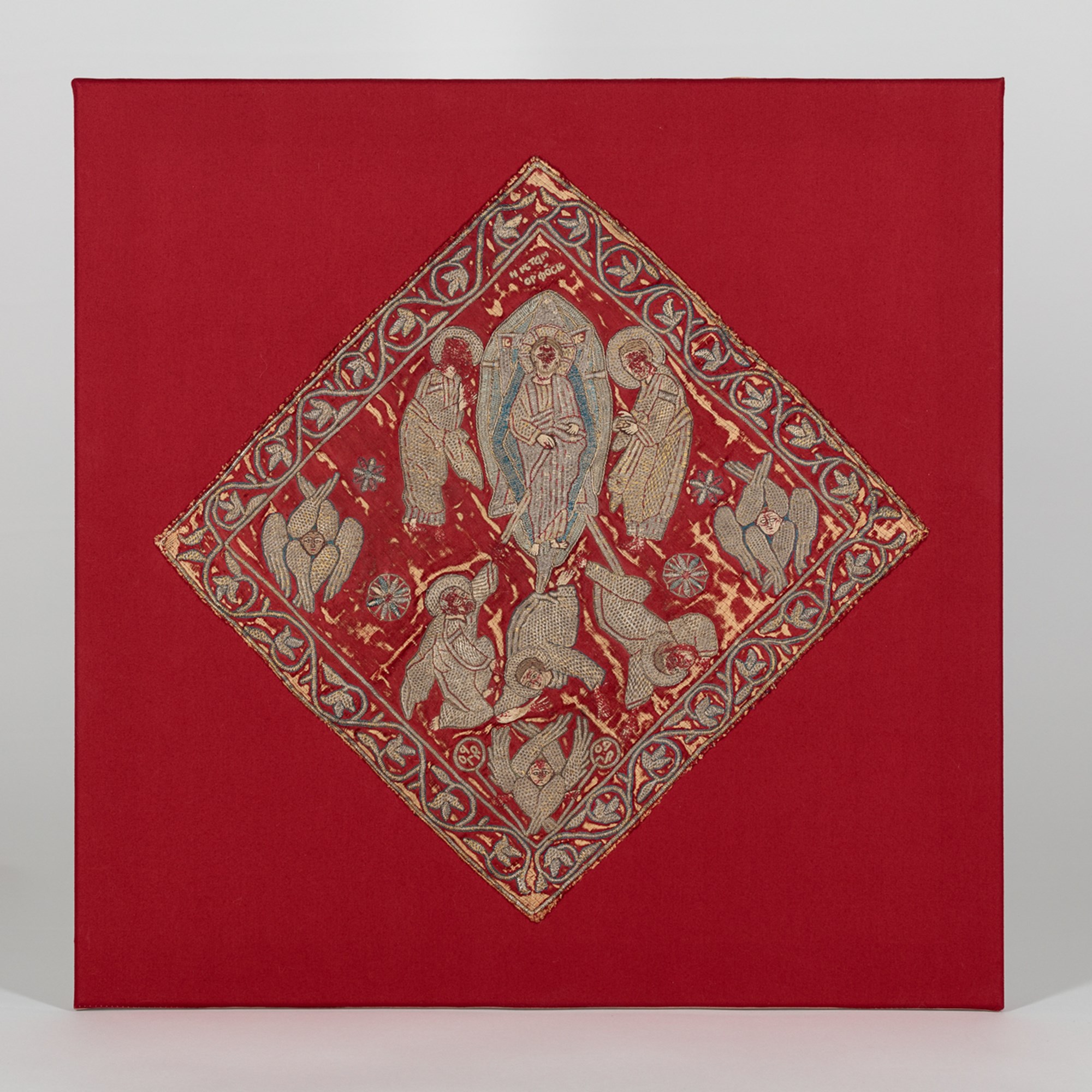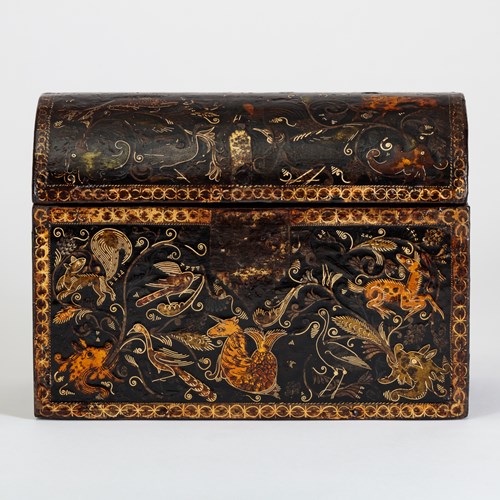Marketplace
An Ottoman Greek Church Epigonation
An Ottoman Greek Church Epigonation
Epoque Late 16th or 17th century
Origine Probably Istanbul, Ottoman Turkey
Dimension 40 cm (15³/₄ inches)
This textile in square shape is embroidered with mainly couched golden threads on a red ground. A repeating Ottoman-style vegetal motif is in the border on all four sides. The central field depicts the Transfiguration of the Christ (the inscription at the top corner, in Greek reads “Metamorphosis”). At the left, right and bottom corner are three six-winged angels (seraphim), the highest rank of angles in Christian angelology. Some eight-pointed stars embellish the composition.
Christ is at the centre of the composition, with Moses and Elijah, two figures from the Old Testament, flanking him on either side. During the transfiguration, Christ’s face became as bright as the sun and His clothes shone white. Unable to bear the light, Christ’s disciples, Peter, James and John fell to the ground.
This type of garment, called epigonation, is only worn in the Greek and Armenian churches. The cloth originated as a towel or handkerchief, but in a strictly formal and ceremonial sense. In the Greek church its use was, and is, confined to bishops. The epigonation is worn suspended in the girdle by one corner to hang at about knee height. Symbolically, the epigonation is said to stand for the Sword of the Spirit, which appears to belong to a conception of the vested bishop. The transfiguration scene of one of the most illustrated.
A similar example, depicting the Transfiguration dated to the late 16th or 17th century, is in the collection of the Byzantine Museum, Athens. The example has a similar vegetal border, composition, as well as the depiction of figures to our example.
This epigonation is an example of the prolific and refined production of Greek Orthodox embroidery in Ottoman Istanbul. During the Ottoman rule, the Greek Orthodox church seemed to have developed a standardisation of iconographic and technical characteristics. While the uniqueness of its eclectic style primarily leans on Byzantine tradition, the generous incorporation of contemporary Ottoman and Western European elements is equally evident. It not only provides a case study for Early Modern artistic melding, but also reflects the comparatively independent social and cultural conditions of the Greek community living in the Ottoman empire.
Comparative materials:
Icon of Gregory of Nyssa, Trebizond, late 17th century, No.33728, Benaki Museum, Athens.
The Transfiguration, late 16th/17th century, Byzantine Museum, Athens.
Johnstone, Pauline. The Byzantine Tradition in Church Embroidery. [Tiranti Library Series]. London: Tiranti, 1967. Plate 53.
Further reading:
Vryzidis, N. (2018). “Ottoman textiles and Greek clerical vestments: Prolegomena on a neglected aspect of ecclesiastical material culture”. Byzantine and Modern Greek Studies, 42(1), 92-114. doi:10.1017/byz.2017.22
Johnstone, Pauline. The Byzantine Tradition in Church Embroidery. [Tiranti Library Series]. London: Tiranti, 1967.
Stock No.: A5359
Christ is at the centre of the composition, with Moses and Elijah, two figures from the Old Testament, flanking him on either side. During the transfiguration, Christ’s face became as bright as the sun and His clothes shone white. Unable to bear the light, Christ’s disciples, Peter, James and John fell to the ground.
This type of garment, called epigonation, is only worn in the Greek and Armenian churches. The cloth originated as a towel or handkerchief, but in a strictly formal and ceremonial sense. In the Greek church its use was, and is, confined to bishops. The epigonation is worn suspended in the girdle by one corner to hang at about knee height. Symbolically, the epigonation is said to stand for the Sword of the Spirit, which appears to belong to a conception of the vested bishop. The transfiguration scene of one of the most illustrated.
A similar example, depicting the Transfiguration dated to the late 16th or 17th century, is in the collection of the Byzantine Museum, Athens. The example has a similar vegetal border, composition, as well as the depiction of figures to our example.
This epigonation is an example of the prolific and refined production of Greek Orthodox embroidery in Ottoman Istanbul. During the Ottoman rule, the Greek Orthodox church seemed to have developed a standardisation of iconographic and technical characteristics. While the uniqueness of its eclectic style primarily leans on Byzantine tradition, the generous incorporation of contemporary Ottoman and Western European elements is equally evident. It not only provides a case study for Early Modern artistic melding, but also reflects the comparatively independent social and cultural conditions of the Greek community living in the Ottoman empire.
Comparative materials:
Icon of Gregory of Nyssa, Trebizond, late 17th century, No.33728, Benaki Museum, Athens.
The Transfiguration, late 16th/17th century, Byzantine Museum, Athens.
Johnstone, Pauline. The Byzantine Tradition in Church Embroidery. [Tiranti Library Series]. London: Tiranti, 1967. Plate 53.
Further reading:
Vryzidis, N. (2018). “Ottoman textiles and Greek clerical vestments: Prolegomena on a neglected aspect of ecclesiastical material culture”. Byzantine and Modern Greek Studies, 42(1), 92-114. doi:10.1017/byz.2017.22
Johnstone, Pauline. The Byzantine Tradition in Church Embroidery. [Tiranti Library Series]. London: Tiranti, 1967.
Stock No.: A5359
Epoque: Late 16th or 17th century
Origine: Probably Istanbul, Ottoman Turkey
Dimension: 40 cm (15³/₄ inches)
Provenance: UK private collectionthence by descent
Plus d'œuvres d'art de la Galerie









